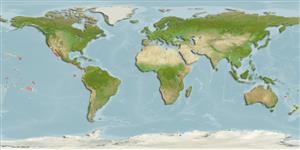Common names from other countries
Environment: milieu / climate zone / depth range / distribution range
Écologie
; profondeur 0 - 30 m (Ref. 96968). Tropical; 30°N - 17°N, 113°W - 106°W
Distribution
Pays | Zones FAO | Écosystèmes | Occurrences | Introductions
Eastern Central Pacific.
Length at first maturity / Taille / Poids / Âge
Maturity: Lm ? range ? - ? cm Max length : 22.0 cm ML mâle / non sexé; (Ref. 96968)
Maximum total length is over 1 meter. It is fished along Baja California, on both sides of the southern Gulf of California and south to Oaxaca. It is fished from March to October (Ref. 96968). This is a benthic species found on soft bottoms, particularly in intertidal and subtidal areas (Ref. 83938). Opportunistic predator, foraging at night on a wide variety of prey (Ref. 108489).
Life cycle and mating behavior
Maturité | Reproduction | Frai | Œufs | Fécondité | Larves
Members of the class Cephalopoda are gonochoric. Male and female adults usually die shortly after spawning and brooding, respectively. Mating behavior: Males perform various displays to attract potential females for copulation. During copulation, male grasp the female and inserts the hectocotylus into the female's mantle cavity where fertilization usually occurs. Life cycle: Embryos hatch into planktonic stage and live for some time before they grow larger and take up a benthic existence as adults.
Hochberg, F.G. and Y.E. Camacho-García. 2009. (Ref. 83938)
Statut dans la liste rouge de l'IUCN (Ref. 130435)
statut CITES (Ref. 108899)
Not Evaluated
Not Evaluated
Utilisations par l'homme
Pêcheries: commercial
| FishSource |
Outils
Plus d'informations
Taille/Âge
Croissance
Longueur-poids
Longueur-longueur
Morphologie
Larves
Abondance
Sources Internet
Estimates based on models
Preferred temperature
(Ref.
115969): 22.3 - 28.7, mean 25.1 (based on 142 cells).
